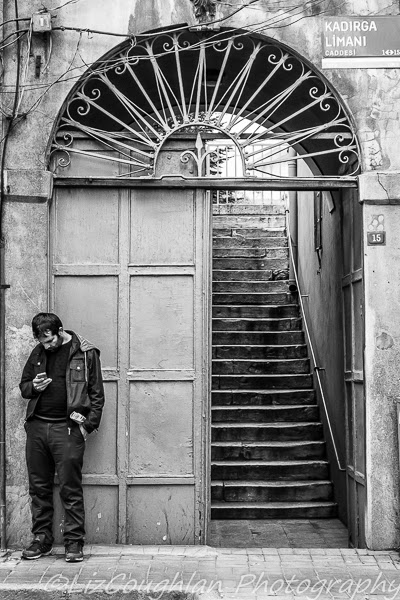Colourful lanterns in Kumkapi, Istanbul
On our second day of street photography with Thatcher Cook, we wandered through the Kumkapi and Kadirga districts of Istanbul. These are fascinating for their history, although now, Kumkapi especially, has become full of touristy fish restaurants
. Despite this, the locals still manage to follow their traditional ways.
A street vendor sells rice and beans from his cart
A junk dealer wheels his barrow through the streets
Kumkapi (or Sand Gate) was the site of Kontoskalion Harbour, originally
built by the Byzantine Emperor, Julian (AD361 - 363), and later becoming the city's naval base under the reign of Michael VIII Paleologus in 1261. In recent times, this harbour has served the fishing fleets bringing their catches from the Back Sea and the Sea of Marmara. There used to be a thriving
fish market in Kumkapi, but this has recently been demolished, ready for new developments.
Entrance to the Church of Panaglia Elpida, Kumkapi
Kumkapi has always been home to a large Greek and Armenian population
, and it grew in importance when the Armenian Patriarch moved here in the 17th century. In fact, the Armenians were in the majority here as late as the 1850s. Because
of the Armenian and Greek influence in this area, there are some beautiful Christian churches
. This is the entrance to the Church of Panaglia Elpida, dating back to the 15th century. We tried to go in, but were rebuffed, so I can only show the entrance.
Greek Church of Saint Kyriaki Kontoskaliou
We did manage to see the beautiful Agia Kyriaki, although we weren't allowed to take photos inside. This church is said to have one of the largest domes, and stands on the site of a sacred spring, dedicated to Saint Basil.
A homeless man sits with his possessions by an old Ottoman fountain.
Sokullu Mehmet Pasa Mosque, Kadirga, Istanbul
Kadirga is a rather run down neighbourhood, dominated by a large mosque built by the architect, Sinan, for Esmahan Sultan, the wife of the Grand Vizier, Sokullu Mehmet Pasa, after whom the mosque is named.
This stall sells sandwiches filled with meatballs (kofte)
This is an area largely ignored by tourists, so the shops and cafes retain their local flavour, despite the recent influx of Ethiopians and Russians. Many poorer neighbourhoods, such as this, will have only very basic cooking facilities
in homes, so buying ready-made food is a way of life. Indeed, it can often be cheaper to eat out in Istanbul, than buy in all the ingredients for home-cooked meals.
The popular kebab shops are everywhere...
...and are often open late into the night
Elizabeth Coughlan












No comments:
Post a Comment
I would love to have your thoughts on any aspect of my blog.